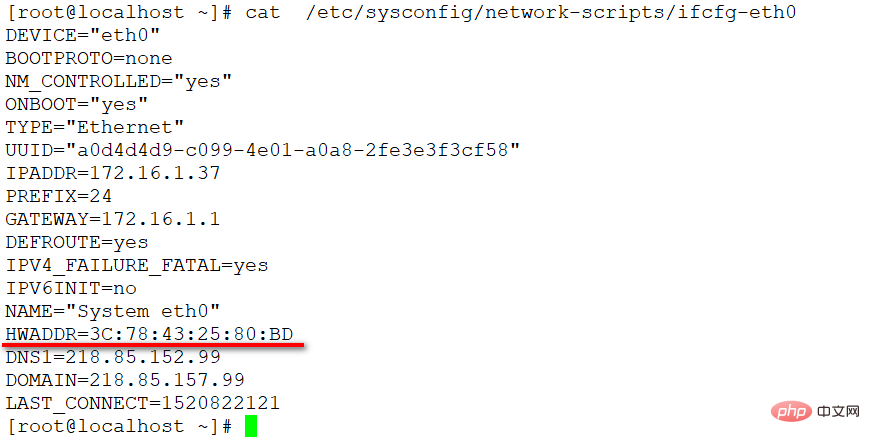 Operation and Maintenance
Operation and Maintenance
 Linux Operation and Maintenance
Linux Operation and Maintenance
 What is the command to query mac address in Linux?
What is the command to query mac address in Linux?
What is the command to query mac address in Linux?
Command to query the mac address: 1. "ifconfig -a", the HWaddr field of the output result is the MAC address; 2. "cat /etc/sysconfig/network-scripts/ifcfg-eth0", read the MAC Configuration file; 3. "cat /sys/class/net/eth0/address"; 4. "dmesg | grep eth0"; 5. "cat /proc/net/arp".

The operating environment of this tutorial: linux7.3 system, Dell G3 computer.
What is the mac address?
MAC (Media Access Control, media access control) is used to define the location of network devices. An identifier used to represent each site on the Internet, expressed in hexadecimal numbers, with a total of six bytes (48 bits). Among them, the first three bytes are codes (high-order 24 bits) assigned to different manufacturers by the IEEE registration authority RA, also known as "Organizationally Unique Identifier", and the last three bytes are (lower 24 bits) is assigned by each manufacturer to the adapter interface produced, called an extended identifier (uniqueness). An address block can generate 2^24 different addresses. The MAC address is actually the adapter address or adapter identifier. MAC is globally unique.
How to query the mac address in Linux
PS: Generally, the default network card file name is eth0, which can be determined based on the actual situation corresponding to the IP address. Just ethx.
1, <strong>ifconfig -a</strong> The HWaddr field is the MAC address, which is the most commonly used method

2, cat /etc/sysconfig/network-scripts/ifcfg-eth0 (CentOS or Redhat configuration file)

below Both types can be viewed before IP is set. Can be used to solve the problem of binding between MAC and operating system. For example, if you install the operating system to a remote server, the mac address of the operating system is the address of host A. On host B, it cannot be started remotely because the MAC address is different (because the configuration file is still the mac address of A at this time). Since the OS will detect the hardware when it starts, obtain the MAC address of the hardware, and write it to the /sys/class/net/eth0/address file, after the OS obtains the mac address, before using the original MAC configuration file (that is, /etc /sysconfig/network-scripts/ifcfg-eth0), write the real mac address into the configuration file.
3、cat /sys/class/net/eth0/address Check the MAC address of eth0

4, dmesg | grep eth0
dmesg' command is very important to diagnose device faults. When performing hardware connection or disconnection operations with the help of the 'dmesg' command, we can see the hardware detection or disconnection information.
5、cat /proc/net/arp View the MAC of the remote IP connected to this machine The address
cannot see the MAC of the local machine, only the remote connection, which is mostly used by the server.
Recommended study: "PHP Video Tutorial"
The above is the detailed content of What is the command to query mac address in Linux?. For more information, please follow other related articles on the PHP Chinese website!

Hot AI Tools

Undresser.AI Undress
AI-powered app for creating realistic nude photos

AI Clothes Remover
Online AI tool for removing clothes from photos.

Undress AI Tool
Undress images for free

Clothoff.io
AI clothes remover

Video Face Swap
Swap faces in any video effortlessly with our completely free AI face swap tool!

Hot Article

Hot Tools

Notepad++7.3.1
Easy-to-use and free code editor

SublimeText3 Chinese version
Chinese version, very easy to use

Zend Studio 13.0.1
Powerful PHP integrated development environment

Dreamweaver CS6
Visual web development tools

SublimeText3 Mac version
God-level code editing software (SublimeText3)

Hot Topics
 1393
1393
 52
52
 1207
1207
 24
24
 What computer configuration is required for vscode
Apr 15, 2025 pm 09:48 PM
What computer configuration is required for vscode
Apr 15, 2025 pm 09:48 PM
VS Code system requirements: Operating system: Windows 10 and above, macOS 10.12 and above, Linux distribution processor: minimum 1.6 GHz, recommended 2.0 GHz and above memory: minimum 512 MB, recommended 4 GB and above storage space: minimum 250 MB, recommended 1 GB and above other requirements: stable network connection, Xorg/Wayland (Linux)
 vscode cannot install extension
Apr 15, 2025 pm 07:18 PM
vscode cannot install extension
Apr 15, 2025 pm 07:18 PM
The reasons for the installation of VS Code extensions may be: network instability, insufficient permissions, system compatibility issues, VS Code version is too old, antivirus software or firewall interference. By checking network connections, permissions, log files, updating VS Code, disabling security software, and restarting VS Code or computers, you can gradually troubleshoot and resolve issues.
 Can vscode be used for mac
Apr 15, 2025 pm 07:36 PM
Can vscode be used for mac
Apr 15, 2025 pm 07:36 PM
VS Code is available on Mac. It has powerful extensions, Git integration, terminal and debugger, and also offers a wealth of setup options. However, for particularly large projects or highly professional development, VS Code may have performance or functional limitations.
 What is vscode What is vscode for?
Apr 15, 2025 pm 06:45 PM
What is vscode What is vscode for?
Apr 15, 2025 pm 06:45 PM
VS Code is the full name Visual Studio Code, which is a free and open source cross-platform code editor and development environment developed by Microsoft. It supports a wide range of programming languages and provides syntax highlighting, code automatic completion, code snippets and smart prompts to improve development efficiency. Through a rich extension ecosystem, users can add extensions to specific needs and languages, such as debuggers, code formatting tools, and Git integrations. VS Code also includes an intuitive debugger that helps quickly find and resolve bugs in your code.
 How to run java code in notepad
Apr 16, 2025 pm 07:39 PM
How to run java code in notepad
Apr 16, 2025 pm 07:39 PM
Although Notepad cannot run Java code directly, it can be achieved by using other tools: using the command line compiler (javac) to generate a bytecode file (filename.class). Use the Java interpreter (java) to interpret bytecode, execute the code, and output the result.
 How to use VSCode
Apr 15, 2025 pm 11:21 PM
How to use VSCode
Apr 15, 2025 pm 11:21 PM
Visual Studio Code (VSCode) is a cross-platform, open source and free code editor developed by Microsoft. It is known for its lightweight, scalability and support for a wide range of programming languages. To install VSCode, please visit the official website to download and run the installer. When using VSCode, you can create new projects, edit code, debug code, navigate projects, expand VSCode, and manage settings. VSCode is available for Windows, macOS, and Linux, supports multiple programming languages and provides various extensions through Marketplace. Its advantages include lightweight, scalability, extensive language support, rich features and version
 What is the main purpose of Linux?
Apr 16, 2025 am 12:19 AM
What is the main purpose of Linux?
Apr 16, 2025 am 12:19 AM
The main uses of Linux include: 1. Server operating system, 2. Embedded system, 3. Desktop operating system, 4. Development and testing environment. Linux excels in these areas, providing stability, security and efficient development tools.
 How to check the warehouse address of git
Apr 17, 2025 pm 01:54 PM
How to check the warehouse address of git
Apr 17, 2025 pm 01:54 PM
To view the Git repository address, perform the following steps: 1. Open the command line and navigate to the repository directory; 2. Run the "git remote -v" command; 3. View the repository name in the output and its corresponding address.





